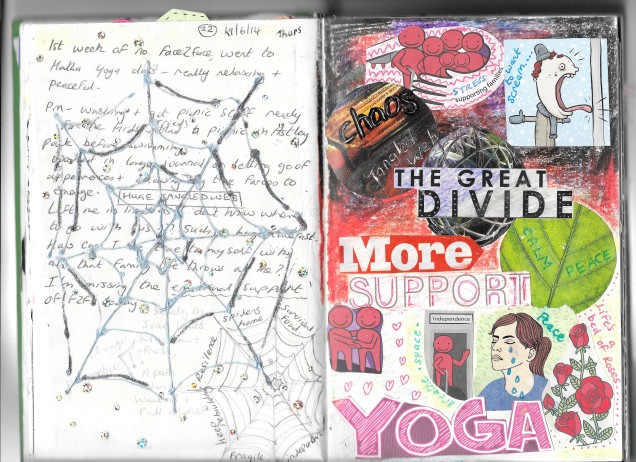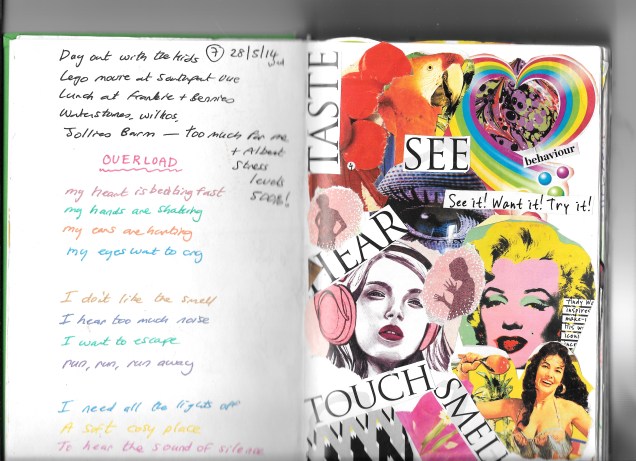Jennifer Kanary Nikolov(a) (Netherlands), Labyrinth Psychotica, 2013 FACT Centre, Liverpool, Merseyside. Installation.
http://www.fact.co.uk/projects/group-therapy-mental-distress-in-a-digital-age/jennifer-kanary-nikolov(a)-(netherlands),-labyrinth-psychotica,-2013.aspx (Accessed 1/5/15)
I visited the FACT centre, Liverpool and spent some time walking around the ‘Group Therapy: Mental Distress in a Digital Age Exhibition 5 Mar – 17th May 2015. As my interest is bedded within ‘Art Therapy’ I had a great interest in this exhibition.
‘Unlike a maze, a labyrinth consists of a single path that twists and turns towards a centre. It is believed that to walk a labyrinth is to embark on a spiritual journey towards oneself.’
Nikolov had used a combination of light sensors, directional sound and LED ‘Hallucination’ poles to create a physical and mental translation of how it might feel to experience psychosis.
It was an amazing experience. I was asked to leave my coat and belongings behind and wear a white coat. This added to a feeling of slight vulnerability. The labyrinth was made up of a series of different fabrics; some smooth, some textured, heavy, light, dark, shiny that were hung very close together and attached down each edge with safety pins. Whilst I did not know what to expect at each turn I found the experience exciting. I could hear a voice as a neared the centre saying “please pick up” at the middle there was a telephone hanging down. I had passed flashing lights, which I did not like and a series of red LED lights.
When I emerged back out of the labyrinth I spoke to the gallery assistant about my experience. I explained that my experience had been positive and fun! He shared with me that out of the hundreds of people who had walked through the labyrinth only himself, me and one other person had found the experience positive!
On reflection, I considered this piece in relation to What is Art, Impermanence, Time, Place and Space. Whilst this piece of Art is not actually reflecting on death, so therefore not impermanence, it does focus on mental health. It allows us to experience and consider for a short time what it may feel like to be suffering from a state of psychosis.
Psychosis Definition
Jennifer Kanary Nikolov(a)
Artist
Jennifer Kanary Nikolov(a) is an artistic researcher. Her art practice roomforthoughts investigates the physics of thought with installation art. Her PhD research Labyrinth Psychotica – Simulating Psychotic Phenomena presents two projects The Wearable and The Labyrinth. Together they form a ‘do-it-yourself psychosis kit’, a form of digital LSD that has been implemented in mental health care organizations around the world to help better understand what if feels like to be in psychosis.
http://www.fact.co.uk/people/artists/jennifer-kanary-nikolov(a).aspx (Accessed 1/5/15)
I was intrigued about other work Nikolov(a) had produced, so researched further via a google search. I found a Youtube video of her work THE WEARABLE, which is an interactive augmented reality cinema walk that functions as a do-it-yourself-psychosis-kit. A form of serious gaming that aims to stimulate our understanding of the subjective experience of being in psychosis. The project also aims to stimulate discourse regarding psychosis simulation projects that have been developed in a scientific context.
(Accessed 1/5/15)
On reflection, I found that after watching this piece of video my heart was racing, I felt tense, uncomfortable and needed a break from my computer screen. I considered the idea that could being stuck in psychosis be a more scary frightening thought than considering death. For me the answer would be yes. I am inspired to look up more Art work that involves mental health illnesses.
I have an interest in Autism and Sensory overload which I suffer from myself at times. I wondered if it would be possible to produce an installation to reflect the experiences of sensory overload. The following YouTube video illustrates this very well.
(Accessed 1/5/15)
I was reminded of some entries into my journal last year both when suffering with depression and sensory overload.












